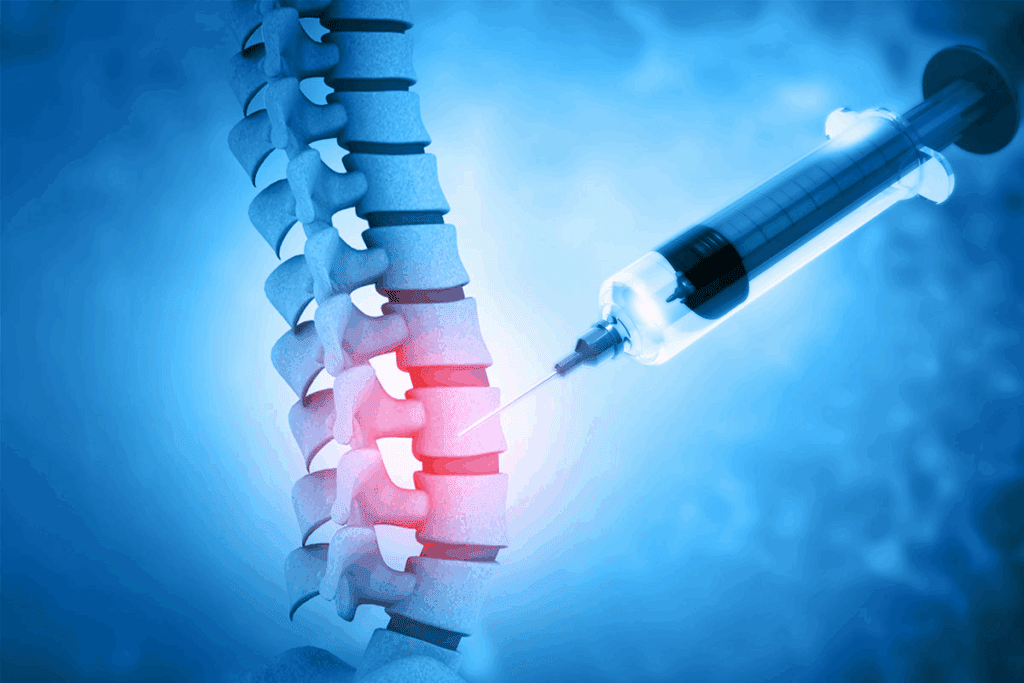Last Updated on November 26, 2025 by Bilal Hasdemir

Managing spinal pain is a big challenge. At Liv Hospital, we use new, patient-focused care to help you get better. Epidural steroid injections are a key treatment for many spinal problems, like lumbosacral radiculopathy and spinal stenosis. Explore the 3 main types of epidural steroid injections. We compare interlaminar, transforaminal, and caudal to see which is best.
There are three main epidural steroid injection techniques: interlaminar, transforaminal, and caudal. Each has its own benefits and is best for certain conditions. We’ll look at these differences to help you find the right treatment for your pain.
Key Takeaways
- Understanding the differences between interlaminar, transforaminal, and caudal epidural steroid injections is key for managing spinal pain.
- Each injection technique has its own benefits and is best for specific spinal conditions.
- Liv Hospital is dedicated to providing innovative, patient-centered care for the best recovery.
- The right epidural steroid injection technique depends on the spinal condition being treated.
- It’s important to talk to a healthcare professional to find the best treatment plan.
Understanding Epidural Steroid Injections for Spinal Pain

Epidural steroid injections are a key treatment for spinal pain. They help people with different spinal issues. Let’s dive into how these injections work to ease pain.
What Are Epidural Steroid Injections?
Epidural steroid injections put medicine around the spinal cord. This area has nerves, blood vessels, and tissue. The medicine used is a corticosteroid, which fights inflammation. It’s often mixed with a local anesthetic for quick pain relief.
How Epidural Injections Work to Reduce Pain and Inflammation
Epidural steroid injections aim to cut down inflammation around spinal nerves. When nerves get irritated, it can lead to pain, numbness, or weakness. By putting steroids in the epidural space, these injections can lessen inflammation.
This reduces nerve pressure and pain. Steroids stop the body from making inflammatory chemicals. This targeted treatment has fewer side effects than taking steroids all over the body.
It’s important to know how epidural steroid injections work. They help by reducing inflammation and easing nerve pressure. This can greatly improve life for those with spinal pain.
The Three Types of Epidural Steroid Injections Explained

It’s important to know the differences between transforaminal, interlaminar, and caudal epidural steroid injections. These injections target different parts of the spine. Knowing their unique features helps in managing pain effectively.
Overview of Transforaminal, Interlaminar, and Caudal Approaches
The three types of epidural steroid injections have different ways of delivering medication. Here’s a quick look at each:
- Transforaminal Epidural Steroid Injections: These injections target the spinal nerve root directly. They offer specific pain relief.
- Interlaminar Epidural Steroid Injections: This method injects steroids between the vertebrae’s laminae. It covers a wider area.
- Caudal Epidural Steroid Injections: Caudal injections reach the lower spine through the sacral hiatus. They’re often used for lower back and leg pain.
Key Differences in Delivery Method and Target Areas
The main differences are in how they’re delivered and where they target. The right choice depends on the condition, pain location, and patient’s body.
Some key differences include:
- The precision of targeting: Transforaminal injections target specific nerve roots. Interlaminar injections cover a broader area.
- The access route: Caudal injections go through the sacral hiatus. Interlaminar injections go between the vertebrae’s laminae.
- The area of effect: The area affected by the injection varies. Transforaminal injections target a smaller area.
Healthcare providers use this knowledge to choose the best epidural steroid injection for each patient.
Transforaminal Epidural Steroid Injections: Precision Targeting
Transforaminal epidural steroid injections are a precise way to treat pain. They deliver medicine right to the nerve root. This is great for sciatica, where pain follows the sciatic nerve.
Procedure and Technique
The process involves injecting a corticosteroid near the nerve root causing pain. It’s done under X-ray to make sure it’s in the right spot. This helps reduce inflammation and eases pain and stiffness.
This method is chosen for its precision targeting of the nerve root. It’s perfect for those with pain from nerve issues, as it targets the pain source directly.
Ideal Candidates and Conditions
These injections are best for those with nerve pain from herniated discs or stenosis. The pain travels along the nerve, and the steroid helps reduce it.
They’re also good for those who haven’t gotten better with other treatments. It’s a good option for avoiding surgery or needing more help.
Advantages and Limitations
The main plus is the targeted relief. The medicine goes straight to the nerve root, making it more effective than general treatments.
But, there are downsides. The pain relief might not last long, and some might need more than one shot. There are also risks like infection or nerve damage, though these are rare.
| Condition | Ideal for Transforaminal Injection | Expected Outcome |
| Herniated Disc | Yes | Significant pain reduction |
| Foraminal Stenosis | Yes | Improved mobility and reduced pain |
| Radiculopathy | Yes | Targeted relief from radiating pain |
Interlaminar Epidural Steroid Injections: Broader Coverage
Interlaminar epidural steroid injections treat pain and inflammation in the spine. They inject steroids into the epidural space through the interlaminar space. This gives broader coverage in the spinal canal.
Procedure and Technique
The procedure involves accessing the epidural space through the interlaminar space. We use fluoroscopic guidance to place the needle accurately. This reduces the risk of complications.
After the needle is in place, a mix of local anesthetic and corticosteroid is given. This reduces inflammation and eases pain.
This method spreads the steroid widely in the epidural space. It’s very effective for conditions affecting many spine levels or causing central canal stenosis.
Ideal Candidates and Conditions
Interlaminar epidural steroid injections are best for patients with multilevel pathology or central canal stenosis. They’re also good for those who haven’t found relief with other treatments. Conditions that may benefit include:
- Multilevel disc herniations
- Central spinal stenosis
- Post-surgical pain
We recommend these injections for patients who have tried other treatments without relief. A detailed evaluation, including imaging, helps us decide if it’s right for a patient.
Advantages and Limitations
The interlaminar approach has several benefits. It covers a wider area and can treat multiple levels at once. This is great for patients with complex spinal issues.
But, there are some downsides. This method may not be as precise as others, like transforaminal injections, in targeting specific nerve roots. There’s also a slightly higher risk of complications, like dural puncture.
Despite these challenges, interlaminar epidural steroid injections are a valuable option for many. By carefully evaluating each patient and using advanced imaging, we can reduce risks and increase benefits.
Caudal Epidural Steroid Injections: Alternative Access
For those with complex spinal anatomy, caudal epidural steroid injections are a helpful option. They deliver relief from chronic pain by accessing the epidural space through the sacral hiatus. This method is great for people who can’t have other types of injections.
Procedure and Technique
The procedure involves injecting a corticosteroid into the epidural space through the sacral hiatus. This is at the base of the spine. It needs precise guidance, often with fluoroscopy, to place the medication correctly.
Key steps in the procedure include:
- Patient positioning and preparation
- Localization of the sacral hiatus
- Insertion of the needle under fluoroscopic guidance
- Confirmation of correct needle placement
- Administration of the corticosteroid
Ideal Candidates and Conditions
Caudal epidural steroid injections are best for patients with specific spinal conditions or anatomy. Ideal candidates are those with:
- Previous spinal surgeries or fusions
- Complex spinal anatomy
- Chronic pain not responding to other treatments
Advantages and Limitations
The caudal approach has several advantages:
- Alternative access for patients with difficult anatomy
- Potential for reduced risk of complications in certain cases
- Effective pain relief for chronic spinal conditions
But, there are also limitations to consider:
- Variable efficacy depending on the individual case
- Potential for increased risk of certain side effects
- The need for precise technique to ensure safety and effectiveness
Understanding the procedure, ideal candidates, and the advantages and limitations helps healthcare providers. They can then make informed decisions about using caudal epidural steroid injections for spinal pain management.
Common Spinal Conditions Treated with Different Types of Epidural Steroid Injections
Epidural steroid injections are key for treating many spinal issues. They help reduce inflammation and ease pain in the spine. We use different types, like transforaminal, interlaminar, and caudal, to effectively treat various conditions.
The right injection depends on the patient’s condition and where the pain is. Knowing the condition and each injection’s characteristics helps us target pain effectively.
Herniated Discs and Radiculopathy
Herniated discs often cause spinal pain and radiculopathy, where nerves are compressed. Transforaminal epidural steroid injections are great for herniated discs. They deliver medicine directly to the nerve root.
These injections not only ease pain but also reduce inflammation around the disc. They help improve symptoms in patients with radiculopathy by targeting the nerve compression.
Spinal Stenosis
Spinal stenosis narrows the spinal canal, causing pain, numbness, and weakness. Interlaminar epidural steroid injections are used to treat this. They put steroids in the epidural space, reducing inflammation and relieving spinal cord pressure.
These injections can greatly help patients with spinal stenosis. They improve quality of life by reducing pain and increasing mobility.
Post-Surgical Pain and Failed Back Surgery Syndrome
Some patients keep feeling pain after spinal surgery, known as failed back surgery syndrome (FBSS). Caudal epidural steroid injections are effective for managing this pain.
Caudal injections put steroids into the epidural space through the sacral hiatus. It’s a safe and simple way to manage pain. It’s great for patients who haven’t responded to other treatments or have reasons they can’t have more invasive procedures.
| Spinal Condition | Preferred Injection Type | Benefits |
| Herniated Discs | Transforaminal | Targets specific nerve roots, reduces inflammation |
| Spinal Stenosis | Interlaminar | Reduces pressure on the spinal cord, relieves pain |
| Post-Surgical Pain/FBSS | Caudal | Safe, minimally invasive, effective for chronic pain |
Interlaminar vs Transforaminal: Head-to-Head Comparison
Understanding the differences between interlaminar and transforaminal epidural steroid injections is key for treating spinal pain. Both methods aim to deliver steroids to the spinal area but differ in their approach.
Anatomical Considerations and Approach
The interlaminar approach injects steroids into the epidural space through the interlaminar space. It’s often used for central or bilateral spinal pain. The transforaminal approach, on the other hand, targets specific nerve roots through the foramen. It’s best for radiculopathy or pain in one limb.
Choosing between these approaches depends on the patient’s anatomy and previous surgeries. The interlaminar method is better for centralized pain. The transforaminal method is more precise for specific nerve roots.
Clinical Outcomes and Effectiveness
Studies show mixed results on the effectiveness of both methods. Transforaminal injections might offer more targeted relief for radiculopathy. Interlaminar injections are better for diffuse or central pain.
The choice depends on the pain relief and functional improvement measures. Both methods can be effective, but the decision is based on patient characteristics and indications.
When Doctors Choose One Over the Other
Doctors consider several factors when choosing between these injections. They look at the patient’s pain pattern, the cause of pain, and their anatomy. For example, severe spinal stenosis might benefit from interlaminar, while herniated discs might need transforaminal.
The decision is made on a case-by-case basis. Understanding the differences helps healthcare providers offer personalized treatments for spinal pain.
Transforaminal vs Caudal vs Interlaminar: Recovery and Aftercare
The type of epidural steroid injection can affect your recovery and aftercare needs. Knowing these differences helps manage your expectations and ensures a smooth recovery.
What to Expect After Each Procedure
After a transforaminal epidural steroid injection, you might feel sore at the injection site. This soreness usually goes away in a few days. Interlaminar injections might cause a feeling of pressure or mild back discomfort, which is short-lived. Caudal injections can lead to a sensation of heaviness or mild discomfort in your lower back and legs.
Right after the procedure, you’ll be watched for any immediate side effects. We suggest resting for the rest of the day and avoiding hard activities for a few days.
Follow-up Care and Additional Treatments
Follow-up care is key to your recovery. We’ll schedule a follow-up to check how the treatment is working and how you’re doing. Sometimes, we recommend physical therapy to boost the effects of the injection.
For aftercare, we advise:
- Watch for signs of infection, like more pain, redness, or fever
- Start doing normal activities slowly
- Keep a healthy lifestyle, with a balanced diet and regular exercise
For transforaminal injections, we might suggest exercises to improve flexibility and strength. For interlaminar or caudal injections, we might suggest changes to your daily activities to avoid making things worse.
Understanding the recovery and aftercare needs for each type of epidural steroid injection helps you prepare. Our team is dedicated to providing full care and support during your journey.
Potential Risks and Side Effects of Each Injection Type
It’s important to know the risks and side effects of epidural steroid injections. These injections can help with spinal pain, but each one has its own risks and benefits.
Common Side Effects Across All Types
Epidural steroid injections can cause some common side effects. These include:
- Temporary increase in pain
- Injection site reactions such as redness, swelling, or bruising
- Headaches
- Nausea or vomiting
- Facial flushing
These side effects are usually mild and go away in a few days. But, it’s key to watch for them and tell your doctor if they get worse or last too long.
Specific Risks by Injection Approach
Each injection type has its own risks because of how it’s done and where it’s aimed.
Transforaminal Epidural Steroid Injections:
- Risk of nerve damage due to the proximity to the nerve roots
- Potential for intravascular injection into the artery supplying the spinal cord
Interlaminar Epidural Steroid Injections:
- Risk of dural puncture, potentially leading to a headache
- Less precise targeting, which may result in variable efficacy
Caudal Epidural Steroid Injections:
- Higher risk of infection due to the caudal approach
- Potential for less effective pain relief due to the distance from the targeted area
Safety Profiles Compared
Transforaminal injections are often seen as riskier because they’re close to important structures. Interlaminar injections are simpler but can have site-related risks. Caudal injections are easier to aim but might not work as well for everyone.
The right injection type depends on the patient’s needs, the condition being treated, and the doctor’s skill. Knowing the risks helps patients make better choices about their treatment.
How Doctors Determine the Right Type of Epidural Steroid Injection for You
Finding the right epidural steroid injection is a detailed process. We look at many things like diagnostic tests, patient history, and pain patterns. This helps us choose the best treatment for you.
Diagnostic Considerations
Diagnostic tests are key in picking the right injection. We use MRI or CT scans to see the spine and find the pain source. These tools help us pick the best injection for you.
Patient History and Anatomical Factors
Your medical history and body shape are important too. We check your past treatments and health to understand you better. We also look at your spine’s shape and any issues to make sure the injection is safe and works well.
Pain Pattern and Location
Where and how you feel pain helps us choose the right injection. We check if the pain is in one spot or spreads, and how bad it is. For example, transforaminal epidural steroid injections are good for pain from specific nerves. Interlaminar injections might be better for pain in the middle of the spine.
| Injection Type | Ideal for | Key Benefits |
| Transforaminal | Radicular pain, specific nerve root irritation | Precision targeting, high efficacy for radiculopathy |
| Interlaminar | Central spinal stenosis, broad coverage needed | Broad coverage, effective for central stenosis |
| Caudal | Lower back pain, sacral involvement | Easy access, less risk of nerve damage |
By looking at all these factors, we can find the best epidural steroid injection for you. This ensures you get the best results.
Conclusion: Making an Informed Decision About Epidural Steroid Injections
It’s important to know about the different types of epidural steroid injections. We’ve looked at three main types: transforaminal, interlaminar, and caudal. Each has its own benefits and things to think about.
Talking to your healthcare provider about your condition and treatment goals is key. Knowing the differences helps you choose the best option for you.
Choosing epidural steroid injections means weighing the good and bad sides. It also depends on your personal situation. Always talk to your healthcare provider to find the right treatment for your back pain.
FAQ
What are the main types of epidural steroid injections?
There are three main types of epidural steroid injections. These are transforaminal, interlaminar, and caudal. Each type is used to treat different spinal conditions.
What is the difference between transforaminal and interlaminar epidural steroid injections?
Transforaminal injections target specific nerve roots. Interlaminar injections cover a broader area. They are often used for more complex conditions.
What is a caudal epidural steroid injection?
A caudal epidural steroid injection is used for complex spinal anatomy. It involves injecting steroids into the caudal canal.
How do epidural steroid injections work to reduce pain and inflammation?
Epidural steroid injections deliver steroids directly to the epidural space. This reduces inflammation and relieves nerve pressure. This helps to decrease pain.
What are the common spinal conditions treated with epidural steroid injections?
Epidural steroid injections treat herniated discs, spinal stenosis, and post-surgical pain. These are common spinal conditions.






